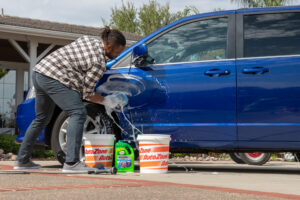Car wax and sealer are popular ways to protect and beautify your car. Both goods have comparable uses but differ in composition, application, and durability. This article compares car wax and sealant’s pros and cons to help you choose a maintenance product.
Understanding Car Wax
Car wax protects and shines paint with natural or synthetic ingredients. Car wax used to be manufactured from Brazilian carnauba palm leaves. Car enthusiasts adore this wax’s warm, rich shine. Synthetic waxes replicate natural wax’s sheen while being more durable and easier to apply.
Car wax is harder to apply than sealants. Clean the car, then apply wax in small parts with a foam applicator. Buff the wax to expose the sheen after a short cure. A gorgeous glossy finish increases paint color and depth.
Advantages of Car Wax
One of vehicle wax’s biggest benefits is its shine and color depth. Car lovers like wax for its warm, natural look, which enhances paint. DIYers choose vehicle wax since it’s easier to apply and remove.
Car wax also protects against dirt, UV radiation, and pollutants. Water repellent properties prevent dirt and grime from clinging to paint. However, vehicle wax only protects temporarily. Environmental variables and automobile washing frequency affect wax finish lifetime.
Negatives of Car Wax
Car wax has benefits and downsides. Durability is a major issue. The protective coating may last weeks to months depending on the wax and conditions. In difficult climates or places with excessive rainfall, frequent reapplication may be needed to preserve protection.
Application time and effort are another drawback. For larger cars, waxing and polishing might take time. Users may sometimes find the process laborious, especially if they desire a perfect finish.
Understanding Sealants are synthetic compounds that provide long-lasting protection for your vehicle’s paint. Polymers make a strong bind with paint, creating a durable protective layer. Unlike natural auto wax, sealants are synthetic and resistant to environmental pollutants.
Sealant application is usually easy. After washing and drying the car, apply sealant with an applicator pad. Many sealants can be wiped off with a microfiber towel after a short curing time, unlike wax, which requires polishing. Sealants are popular for fast and effective paint protection due to their simplicity of application.
Advantages of Sealant
Durability is a major benefit of sealants. Sealants might last six months to a year, depending on product and conditions. This long-lasting protection implies fewer treatments over time, making them ideal for busy people or those who want to reduce upkeep.
Sealants resist UV, oxidation, and chemicals well. They form a strong protective coating that keeps paint intact over time. This protection is especially useful for persons living in harsh weather or polluted places.
Negatives of Sealant
Sealants are beneficial yet have downsides. Sealants lack car wax’s shine, which is a major worry. They may improve paint gloss but lack the warmth and richness of wax finishes, which automobile aficionados prefer. This can be important for aestheticists.
Proper application is another drawback. Sealants are easy to apply but need a clean, dry surface to bond. If applied incorrectly or on a dirty surface, sealant may not adhere effectively, resulting in uneven protection and poor performance.
Comparing Durability
Durability matters when comparing automotive wax and sealant. Most automobile waxes, especially natural ones like carnauba, last a few weeks to a few months. This short lifespan implies automobile owners may need to wax more often, especially in bad weather.
In contrast, sealants protect longer. Sealants protect paint longer, lasting months to years. Sealants are selected by many car owners who want a low-maintenance solution due to their durability.
Compare Application
Another difference between automobile wax and sealants is application. The vehicle must be washed and dried before applying car wax in small portions and polishing it for a polished finish. Detailing can be time-consuming and laborious for beginners.
Sealants demand less work. Quick and easy to apply, they’re generally wipe-on, wipe-off. Sealants appeal to busy people and auto detailing beginners due of their simplicity.
Beauty Factors
Both automotive wax and sealants protect, although they look different. Car wax is popular for its deep, warm gloss that enhances paint color. For show cars and automobiles on exhibit, wax is popular with car enthusiasts and detailers due to its rich shine.
Sealants are usually more reflecting. They may not give wax depth, but they can improve car look. Sealants can provide protection above aesthetics, especially with proper maintenance.
Concerns about cost
Cost is another consideration while choosing auto wax or sealer. Overall, car wax is cheaper than sealants. Due to product longevity, the cost may balance out over time. Although wax is cheaper immediately, more frequent applications might raise the expense over time.
Sealants are more expensive initially but last longer, making them a superior investment. Sealants save money by requiring fewer treatments and providing longer-lasting protection. This affordability appeals to car owners who want to preserve their investment.
Making the Right Choice
Car owners should choose car wax or sealant based on their needs. If you like aesthetics and hands-on detailing, vehicle wax may be right for you. Fans love it because it gives your car a warm, deep sheen.
If you want durability, simplicity of application, and long-term protection, a sealant may be better. This synthetic formula and great bonding ability make it a practical way to maintain your vehicle’s appearance without numerous reapplications.
Conclusion
In conclusion, automotive wax and sealant offer pros and cons for different needs. Car wax is popular for its rich sheen and ease of usage, while sealants are durable and long-lasting. Consider your needs, climate, and time commitment to car maintenance while choosing. Both treatments can protect your car’s paint and keep it looking good.




